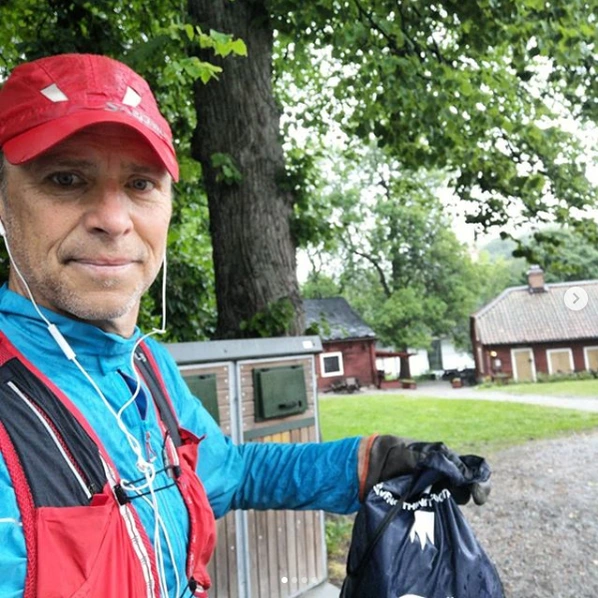- History of plogging.
- Where and how to do plogging.
- How do you become a plogger?
- What do you need to know before leaving for an Eco-jogging and what do ploggers collect?
1. History of plogging
Plogging refers to the process of collecting garbage while jogging, and the term is the result of the fusion of two words: “plocka” (Swedish: lift) and “jogging“.
Plogging originated in Sweden in 2016 as a sporting activity and quickly spread to all countries, mainly through social media.
Swedish ecologist Erik Ahlström, a fan of light jogging in the fresh air, moved from a small town to Stockholm. He was very impressed by the amount of garbage in the streets of the capital. He then began to carry bags with him during training, putting everything he found on the street inside them.

In addition, he created the website Plogga.se to find and reward volunteers on the internet. The site is also available in English, so you can familiarize yourself with the general concepts and events of this movement.
Briton David Sedaris, one of the founders of plogging, combined garbage collection with exercise, taking up to 60,000 steps a day in search of local garbage. He was so much effective in keeping his area clean that the local authority named a garbage truck by his name.

In addition, the novel movement immediately became part of the traditional original “Hygge” lifestyle, based on the link with nature and its protection.
2. Where and how to do plogging?
The events organized for enthusiasts can have different levels:
- Plogging “at home” – cleaning the neighborhood, yard;
- At school or college level, involving a group of friends or a sports team;
- “Corporate” plogging – a great way to unite the company’s team, have fun in the fresh air and do a good deed;
- Organization of regional events;
- Conferences and projects at municipal or national level.
It is also a great informative event that participants can share on social networks and thus draw attention to the problems associated with waste and environmental pollution.
Don't like running? No problem!
Apart from plogging, you can do eco kayaking and eco diving or simply walk along the beaches and collect garbage.
Now, unfortunately, garbage is present practically everywhere, so it is not surprising that “exotic” activities such as eco-climbing have also emerged. Congratulations to the activists of the Eco-Everest movement who removed 13,500 kg of garbage from the highest mountain in the world!

A movement like Planet Patrol (formerly Plastic Patrol) has shown great efficiency, which, in addition to combining physical activity and garbage collection, aims to collect useful data, for example, indicate the places of pollution on a map, take photographs of objects among the garbage to understand which are the most polluting brands for nature. They create waste maps, analyze the data and conduct relevant environmental studies based on data collected by volunteers.

3. How do you become a plogger?
You simply need to:
- Wear comfortable clothes and sneakers.
- Bring one, or preferably two, sturdy garbage bags with you. During the ride, you can hang them from the left and right sides to distribute the load evenly.
- Collect garbage found along the way.
- You can take a picture of the “treasure” and post the photo with the hashtag #plogging on Instagram.
Congratulations, you have become a plogger!
4. What do you need to know before leaving for an Eco-jogging and what do the ploggers collect?
Rule 1. Plogging shouldn’t be a record-breaking run or a health risk. Its main goals are to actively and usefully spend time in the fresh air, as well as to make the place where you live more comfortable and cleaner. It helps to regain harmony with nature and increase environmental awareness. Parents or educators who practice plogging set a great example to their children by promoting a culture of caring for the environment.
Rule 2. Ploggers are not professional cleaners and do not have the task of cleaning up huge landfills. If you find such a landfill, you need to contact the municipality that has adequate equipment and personnel.
Rule 3. Strict hygiene rules must be observed and protective gloves and garbage bags must be used. The waste collected should therefore be separated accordingly to its type and disposed of in a proper way.

So it’s all simple! Plogging can be a great hobby and, to some extent, also a psychological therapy, because by helping other people and nature you help yourself. You become better, more aware, you set a good example to other people. Remember the phrase “Think globally, act locally”? And plogging is a great way to make your small but very important local contribution!








ladesbet ウェブカメラ
05/04/2024 at 07:13ladesbet 妊娠中のポルノ ladestinemi.ZMkhFEQO2EW
ladesbet ਕਿਸ਼ੋਰ ਪੋਰਨੋਗ੍ਰਾਫੀ
05/04/2024 at 05:33ladesbet ਈਬੋਨੀ ਪੋਰਨ ladesinemi.Oig54ClPKrh
링크모음
04/04/2024 at 19:24Thank you for the auspicious writeup. It in fact was a amusement account
it. Look advanced to far added agreeable from you!
However, how could we communicate?
swinger ਪੋਰਨ ਹੈ
03/04/2024 at 16:05ਵੱਡੀ ਛਾਤੀ ਪੋਰਨ madisonivysex.gu2GcRpwscw
एशियाई अश्लीलता
02/04/2024 at 18:25मिश्रित अश्लीलता hkyonet.JuIa4dOh0Mi
Add a comment